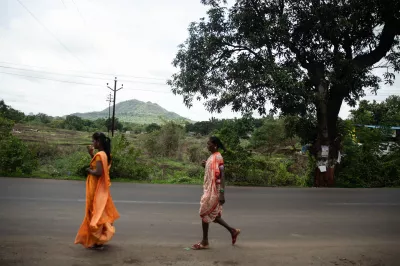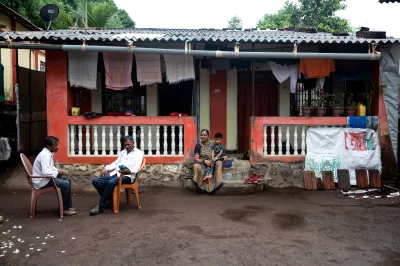India’s Unique ID Could Generate Big Boost in Financial Access
In 2009, shortly after getting wind of the newly formed Unique Identification Authority of India (UIDAI), a few of us from CGAP met their new team at a technology park in the software capital of India – Bangalore. That first meeting was held around a makeshift table with some of us seated on computer boxes. It felt as if we were meeting a tech start-up.
We had heard about ambitious plans to change how all Indians could identify themselves in order to access services and other benefits. Language, required documents, social barriers and red tape had long made it cumbersome to access many services – including banking. These were longstanding, seemingly insurmountable problems for India. We were curious to learn more and followed it with great curiosity.
The newly appointed head of the UIDAI, Nandan Nilekani, had a grand vision articulated in his book, Imagining India: the Idea of a Nation Renewed. The ambition was massive. UIDAI aimed to provide a unique identification number to all residents– some 1.2 billion people – across a vast and diverse geography. More than that, they aimed to leapfrog by capturing biometrics - finger prints and iris scans. Biometrics would prevent multiple enrolments by the same individual (a problem for many existing service programs), while also providing nearly foolproof identity authentication.
 A man scans his irises for purposes of biometric identification in India
A man scans his irises for purposes of biometric identification in India
Photo Credit: Jeanette Thomas
While we admired the sheer ambition of the project, like most we were a bit circumspect of whether it could be pulled off. It seemed far-fetched to imagine it could tackle the bureaucratic maze, linguistic variances or centuries’ old social barriers across India. Yet as we followed UIDAI, it gained momentum and met each logistical and political barrier. Today, UIDAI is poised to transform India in many ways. It could fundamentally change access to finance in one of the largest global markets.

In collaboration with India’s Home Ministry, state governments, banks and other organizations, over 600 million people have been enrolled for an Aadhaar (loosely transited meaning “foundation) number. The process is efficient with some 560 million of these already receiving their Aadhaar number. These numbers expand each day as enrollment gathers steam. Political expediency has meant focusing enrollments in about half of India’s provinces in the current phase. But practically it could soon be nationwide, as Rajesh Bansal Assistant Director General at UIDAI notes, “UIDAI is well on its way towards becoming an enabling platform for over a billion people who can be formally recognized and included.”
 A woman registers for Aadhaar in India
A woman registers for Aadhaar in India
Photo Credit: Jeanette Thomas
There are wide ranging uses for the UIDAI, but access to finance has been an early focal point. Already there are 58 million bank accounts linked to a UIDAI number, a sharp rise from the less than 2 million just 12 months ago. This has enabled a large amount of subsidies to be transferred over a UIDAI linked payment system (55 million in the past six months). Already one out of six consumers of liquid petroleum cooking gas (used widely across India) receives their subsidies this way. There are ongoing efforts to link the large national rural employment scheme (National Rural Employment Guarantee Scheme) and pensions. Bansal of UIDAI, building on the confidence gained in 2013, conservatively projects that over 150 million bank accounts will be linked to Aadhaar by the end of this year alone.
 A man scans his fingerprints for the Aadhaar program in India
A man scans his fingerprints for the Aadhaar program in India
Photo Credit: Jeanette Thomas
Financial sector policy makers recognize the potential Aadhaar brings. In September 2013, The Reserve Bank of India (RBI) made it possible for any person with their Aadhaar to apply for a bank account and validate their identity with their fingerprints. No proxies are required, no letter from a village elder, no need to seek documentation from multiple other government offices.
But perhaps the biggest boost came early this month. The Committee on Comprehensive Financial Services for Small Businesses and Low Income Households formed by the new Governor of RBI, makes proposals with Aadhaar as a critical enabling factor. The committee’s report proposes to make bank accounts universal within two years across India. All adults over age 18 should have an account by January 2016. Aadhaar is the infrastructure which makes this feasible in such a short time frame. As Bansal of UIDAI notes: “The RBI Committee’s goals for universal access by January 2016 is absolutely achievable and we are well on our way towards achieving that goal.”
The lofty goal of reaching Aadhaar enrollments and a clear link to financial accounts seemed wildly ambitious back in 2009 when we were sitting around UIDAI’s makeshift office. But today, India stands on the precipice of meeting that grand ambition. There will be more challenges to be sure. Uptake by clients will require more attractive products; a simple account is not enough. At CGAP we have studied the implementation challenges of delivering social payments with Aadhaar. Banks will need to be creative if they are to seize the opportunities of lower costs of account opening. Like in many other countries, there is an important debate about the implications of Aadhaar on data privacy.
These are all important considerations, but 2014 could well mark the beginning of a new era for financial inclusion in India. Aadhaar’s progress puts India in a position to consider possibilities that were out of reach a few short years ago.
Watch this space for forthcoming posts about India's vision for financial inclusion set out in the new Report of the Committee on Comprehensive Financial Services for Small Businesses and Low Income Households.




Comments
Aadhaar number shall be a
Aadhaar number shall be a game changer for inclusion efforts in India, there can not be two opinions about it. At the very basic, for millions and particularly mobile persons, it provides a credible identity acceptable at all places. A few steps shall be critical for success of Aadhaar programme:
- banks/ departments/ mass users need to have biometric devices capable of confirming the identity of the persons only when the usage of Aadhaar shall increase. UIDAI need to facilitate this by making it free and taking over the responsibility for its accuracy.
- -Aadhaar should not try to achieve many things simultaneously- let it be a simple identity provider and let each department/ programme find its usage.
- in Indian democracy, approval of Parliament for Aadhaat programme must be obtained, which shall give it more validity in the eyes of all.
- For FI its potential is enormous but banks will not bite the bullet as it will lead to millions of low value accounts which shall be difficult to handle at present branches/ agent locations.
I think once UIDAI has issued most of Aadhaar numbers, it will need to be converted into a payment bank or need to float a payment bank of its own, if it is to prove the true potential for FInancial Inclusion. Till then banks shall remain its reluctant partners.
( Banking for Poor, Karnal, India)
How many of those Aadhar
How many of those Aadhar-linked bank accounts come from the new pools of Aadhar enrollees? I.e. how many new accounts were created as a result of Aadhar enrollment?
Very Interesting. It’s
Very Interesting. It’s impressive, the fact that Aadhaar is the first of its kind unique identification system in India and has successfully created an ecosystem for itself by garnering support from various government schemes and Indian masses. While I agree with the benefits that Aadhaar has, I have a few concerns like is Aadhaar really bringing in financially excluded when even to get an Aadhaar issued an individual has to submit a POI/POA. The growth rate of Aadhaar enrolments is motivating but is it really promising, given the real financially excluded rural/remote areas face issues such as connectivity, fingerprints not matching due to manual labour/dryness and the point that old age individuals have a particularly hard time in validating their fingerprints.
But yeah, as the infrastructure evolves, we look forward to the real benefits Aadhaar will generate.
It very unfortunate that our
It very unfortunate that our politicians dont understand the need for the Identification of the Indian Citizens and so delay the passing of the National Identification Authority Bill.
This is the new phase for
This is the new phase for financial inclusion in the financially excluded zones as reflected by the Nigeria governments implementation of a similar project known as the National Identity Number. Cementing the projects possibilities and opportunities with regards to advancing access to financial services to the rural areas through a positive data collation and processing, the apex microfinance institutions known as ANMFIN has entered an MOU to deploy its cloud based banking application for microfinance institutions to serve as a pre-enrolment platform to be able to expand and reach out to microfinance customers across the country to facilitate the number of persons that will be provided with the NIN. Most importantly, these will reduce cost of providing service as it will checkmate fraud, over indebtedness, and risk in loan management and portfolio diversifications.
Add new comment